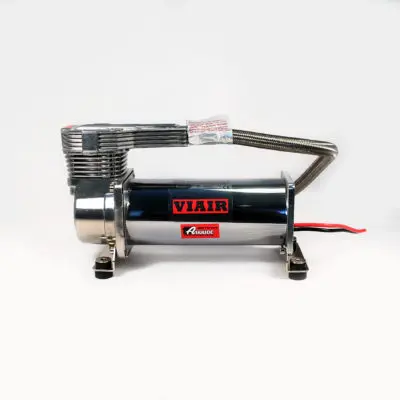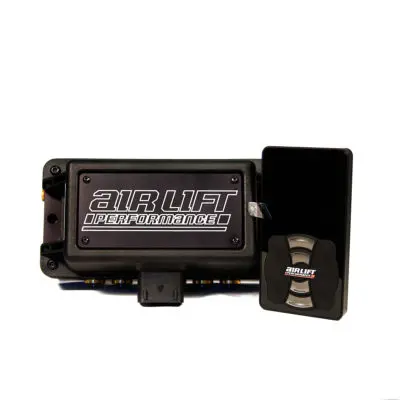Air suspension – the basics
NB: There is no such thing on a car as a shock absorber – the spring is the shock absorber. What many call the shock absorber is in fact the damper – in a car without air suspension, this moves up and down with the wheel in order to slow down and eventually stop any movement of the spring.
So, what is air suspension all about?
In essence, it involves replacing the standard spring that all modern vehicles have (typically a coil spring for cars or a leaf spring for larger vehicles) with an air bag. An air bag is often also called an air spring or bellows.
With a normal coil spring, the rate of compression is measured for the most part in pounds per inch (i.e. how many pounds of load are required to compress the spring by one inch.) That figure would normally be somewhere between 100-1000 lbs/inch. The rate is normally fixed.
For instance, a 200 lb/inch spring will compress by one inch when a load of 200 lbs is placed on it, and by two inches when a load of 400 lbs is placed on it.
The spring rate is usually fixed at manufacture. Because the weight of the car and spring rate are both constant, the ride height of the vehicle is also constant. This remains the case until you go over a bump, at which point the load on the spring then varies, and so the ride height varies.
When you fit air, you change the metal spring for an air bag (or spring). This basically carries out the duty of the metal spring but still needs a damper to operate correctly.
Why is this better?
The advantage to the air bag is that it has a variable spring rate – the more air you pump in, the higher its spring rate. Thus, by inflating the bag you can take the spring rate from 0lb/inch (with no air) to as much as 600lb/inch at maximum pressure (about 200 PSI (pounds per square inch)).
This variable rate has two effects. Firstly, the higher the spring rate, the more load is required to compress the spring. Secondly, the ride height of the vehicle will now vary in proportion to the air pressure used inside the bag.
The height of the front bumper from the ground might be four inches but rise to nine inches, depending on the amount of pressure (PSI). Thus, we can control the height of the vehicle simply by the addition or subtraction of air from the bag.
On top of the ability to lower and raise the ride height of your car, air also gives a smoother ride, better handling (including improved cornering) and it just looks cooler!

A double-convoluted air bag
What is an air bag and how is it fitted?
Air bags (or air springs) come in various shapes and sizes but in European cars (FWD not RWD or 4WD) we mostly use double-convoluted bags (in bead-seal and crimped-end varieties). These have a good range – from fully-up to fully-down of about five inches – although the vehicle is normally driven at a height towards the upper two thirds of that range.
The bags must be fitted by brackets, as they bolt onto a flat surface and the original springs do not. In the front of a FWD car, a different approach is needed as the airbag must surround the damper for the suspension to function. As this can be quite complex, it is important to choose your air bag from a reliable supplier to ensure there are no problems mounting the bags in this manner.
Where does the air come from?
We supply compressors (effectively pumps) that fill an air tank with air at a pressure between 130 and 200 PSI. The compressor is powered from the car battery (we can fit a second battery if required, so you can never end up with a flat battery that can’t start your car).
With motorhomes, caravans, and basic van kits, you can to go to a workshop or petrol station and use a tyre inflator to fill the system with air – this is great for a van or motorhome needing a fill once a month or so but we would always recommend a compressor to ensure you never run out of air.
The less-basic van systems can use a very small compressor with no air tank, and the compressor pumps up the bags directly. Again though, ideally it is best to have both a compressor and an air tank.
We have a dedicated page on compressors here.

The Viair 485C compressor – the most high-spec compressor we sell
How long does air take to work?
A slow system uses a small compressor and small tank and will lift the car 1–1.5 times before the tank is empty. A small compressor would take around five minutes to refill the tank and it would take around 15 seconds to lift the average car from fully-down to fully-up.
A fast system (our standard) uses a far-larger compressor. Using quarter-inch valves and lines, it would lift the car in about two to three seconds. It would also lift the car 2.5 times on a tank of air and take around three minutes to refill the tank.
An ultra-fast system would probably use two compressors, a larger tank and half-inch valves instead (the bigger the valve, the quicker an air suspension system will work.) This would lift in under two seconds and take less time to refill the tank, although not half the time.
Each system can be custom-built to the customer’s specifications depending on what the objective is.
How is air controlled?
The most basic air control system is a simple mechanical paddle, like an electric window switch, which basically opens and closes a tap to let air in and out. This is unsophisticated and very slow, but it is reliable and is the system of choice on vans for load levelling and load support. These systems typically take between 20 seconds and five minutes to lift the vehicle.
Alternatively, you can use solenoid valves. These are again basically electrical taps that open and close. Cheap solenoids are nothing but trouble and continuously go wrong. High-quality valves can cost up to ten times the cost of cheap and unreliable ones, and as such many are suppled from the US.
However, solenoid valves open up a number of control possibilities. The most basic is again a simple electric-window switch – up is up/down is down – and you can stop the car anywhere you want in between the two.
They can also come in a ten-switch box, which gives the ability to lift and lower the entire car in one hit, and is often fitted on a long lead, so it can be operated from outside the car.
We also sell a computerised controller which has built in gauges to read the pressure in each bag. This has the added benefit of a UK-legal remote control which allows the entire vehicle to be adjusted in one hit to three pre-set positions. These are normally set to fully-down, drive and fully-up, but can be set to anything you want. This item is great for simplicity, reliability and even cool factor!
Another major benefit to the computer system is that it can be controlled with a phone app, either on Apple or Android. The app is free, has lots of different functions, and means you don’t have to bother with a controller. Some people also modify PlayStation controllers and use them instead of a regular remote.

The AirLift 3P digital computer system can be used with a phone app
What are pressure sensors?
The most basic systems have no way of knowing how high the vehicle is without someone getting out and looking.
Mid-level systems use standard 52mm gauges which have two needles in each gauge and read the pressure mechanically.
The computer listed above uses sensors in each circuit to read the pressure and shows it on an LCD display.
In summary
Overall, the best components in each area will provide the fastest operating system. These can also (but not always) be the most reliable systems. It is a peculiarity of the market that mid-level systems tend to be the least reliable (although note the word ‘least’, they are not unreliable). The top-level computerised system is the fastest and very reliable in use.
Reliability should be considered a very important factor, as any fault in the system – whether mechanical, electrical or pneumatic – will tend to render the vehicle unusable and difficult to recover due to the low stance. In the event of a failure the car will almost certainly end up at the lowest setting possible.
In almost 20 years of selling air suspension parts and kits, we are proud to say that we have never had a fault or breakage reported back to us.